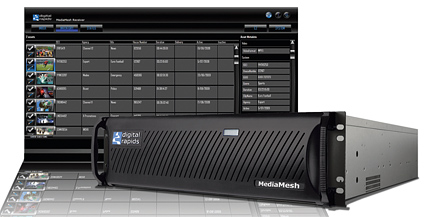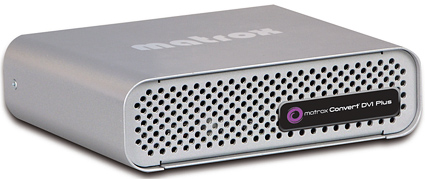Transcoding for the News Workflow
SEATTLE—For those of us with gray hair and reasonably good memories, there were the good old days, when a station shot video in NTSC, delivered it back to the station either on tape or via microwave or satellite in NTSC, edited that video in NTSC, and played it out to the viewers in, yes, NTSC.
Today there is a mish-mash of formats news is shot in, transported back to the station in, and edited in. And though the primary playout to viewers is in ATSC, news stories are also played out to Web, smartphone and what-have-you viewers.

Digital Rapids MediaMesh While a case can be made for the advantages and capabilities advanced by working in all those formats, it has also made a thriving business for vendors who sell transcoding devices, which are designed to fit into various points in the newsroom workflow to get you from this format to that.
TAKE THE BEST STREAM IN
"You want to bring content in at the best format that you can, so that when you're transcoding it to lower resolutions you can maintain the highest quality," said Howard Barouxis, ATEME vice president and general manager for the Americas. "And that's why you should give some care in bringing it into the NOC. You know, garbage in, garbage out, you want to take the best stream in for transcoding."
ATEME provides transcoders for both contribution and distribution. For basic contribution feeds, they pair the CM3101 encoder with their DR8100 integrated receiver decoder, and a higher-end CM4100 with their DR8400, which Barouxis said included "every kind of MPEG codec or format, MPEG2, MPEG4, 4:2:2, 4:2:0."
For transcoding for distribution over mobile networks, the Web and so forth, ATEME provides its Titan products, the Titan Live for transcoding live video, and the Titan File for transcoding video files.
Avid's transcoding product—Avid Media Access, or AMA—integrates as a plug-in to its editing system architecture, according to Jim Frantzreb, senior broadcast segment manager at the Burlington, Mass.-based company. It has implementations for Sony's XDCAM and many of the other professional camera formats.
"You plug in the camera, or the device file reader into the laptop or system CPU, and the material just shows up in an Avid bin on the editor, and you start editing," Frantzreb said. "You don't have to import it first, so it's the fastest ingest workflow. You can jump between HD and SD, 1080i and 720p, it doesn't matter."
Avid has also implemented the ability to use the various consumer formats that user-generated content comes in, from cellphones and other cameras that viewer submitted content comes to the station in.
Digital Rapids has a number of products that play the role of transcoding in the TV news workflow, according to Mike Nann, director of marketing and communications for the Markham, Ontario provider of transcoding technology. For example, he said, there's the company's C2 delivery software, "where the idea is to accelerate the transfer of large video files over an open Internet connection." The system eliminates dropping bits and timing out.
On the studio side, Digital Rapids' MediaMesh "automatically knows exactly what format the file needs to go into," said Nann. "The great thing is that it completely frees the guy in the field from having to worry about what happens back at the studio." In addition to transcoding into an editing format, MediaMesh can simultaneously transcode for Internet or mobile delivery directly to viewers.
Archive access is a transcoding area that Masstech has focused on. "We've introduced products to provide archive access to news operations that are on AP's ENPS and Avid's iNEWS systems," said Joe French, president and CEO of Masstech in Richmond Hill, Ontario. "Newsroom staff can research archived content, search slugs linked to video archives, browse archived content, and quickly make shot selections without moving from their desk." That product is called Emerald.
"We have focused on high resolution formats like HDCAM and others, and our company has set a benchmark for speed of transcoding speed of high definition," he said, with products like Masstech's CatchBLUE. Masstech was the transcoding supplier for host CTV at the Vancouver Winter Olympics. Sinclair Broadcast Group recently announced that it has deployed Masstech CatchBLUE v7.5 Special Edition systems to transcode content from Pitch Blue and Javelin syndicated delivery services for its group of 58 stations nationwide.
OUTSIDE CONTRIBUTIONS
Broadcasters dealing with an increasing influx of viewer-generated video contributions as well as online video formats want a quick, efficient process that maintains quality.
"A lot of newsrooms are using Skype sessions to bring in video, or wanting to add content from YouTube, or browsing Web pages for notes of interest to the community," said Wayne Andrews, senior product manager at Matrox Video Products Group in Montreal. "They want to scan and convert that to HDSDI with genlock, and while it's not transcoding per se, it's gaining a lot of momentum."
Matrox provides a range of products for both the Mac and the PC, such as its Convert DVI. "It's a high definition scan converter with genlock," Andrews said.

Matrox Convert DVI Plus On the output side, Matrox can provide the video for playing to air as well as other modes of delivery. "We provide a bunch of presets, one's for iPad, one for iPad2, for iPhone, all the way through Blu-ray, all the way down to Web, YouTube, Flash. There are over 300 options."
"In some cases transcoding is going to happen at the station," said John Pallet, Telestream's director of product marketing for enterprise products, "sometimes in the field, and sometimes both." His company provides products for field and studio.
"In the field, we have Wirecast for live streaming, which is capable of switching between multiple camera feeds, and Episode for file based transcoding. Back at the studios, we have our FlipFactory and Vantage to take a captured feed, transcode it and send it to edit or to air."
Pallet noted that studio transcoding equipment finds use beyond the newsroom. "Commercials and non-news content, very little of it arrives at a station ready for air." And then there is user-generated content, news material captured by viewers on their cellphones and a myriad of other consumer cameras, which need to be transcoded to a format the station can air.
Viewcast specializes in transcoding that facilitates delivering TV station news products to viewers on devices other than their televisions. "What we really focus on is content being delivered to laptops, PCs, tablets, smartphones, all those other kinds of devices," said David Stoner, president and CEO of Viewcast in Plano, Texas.
"A television station might have a site for breaking news, or maybe for in-depth coverage of an event that got 30 seconds on the Ten O'clock News," he said. "It could be live coverage, or on-demand playback of a story."
Two Viewcast products that provide playback via Web, phones and so forth are the Niagra 7500, which is rack-mountable, and the portable Niagra 4100. With the 4100, an event such as a high school ball game could be streamed directly to the Internet without passing through the station.
Get the TV Tech Newsletter
The professional video industry's #1 source for news, trends and product and tech information. Sign up below.
